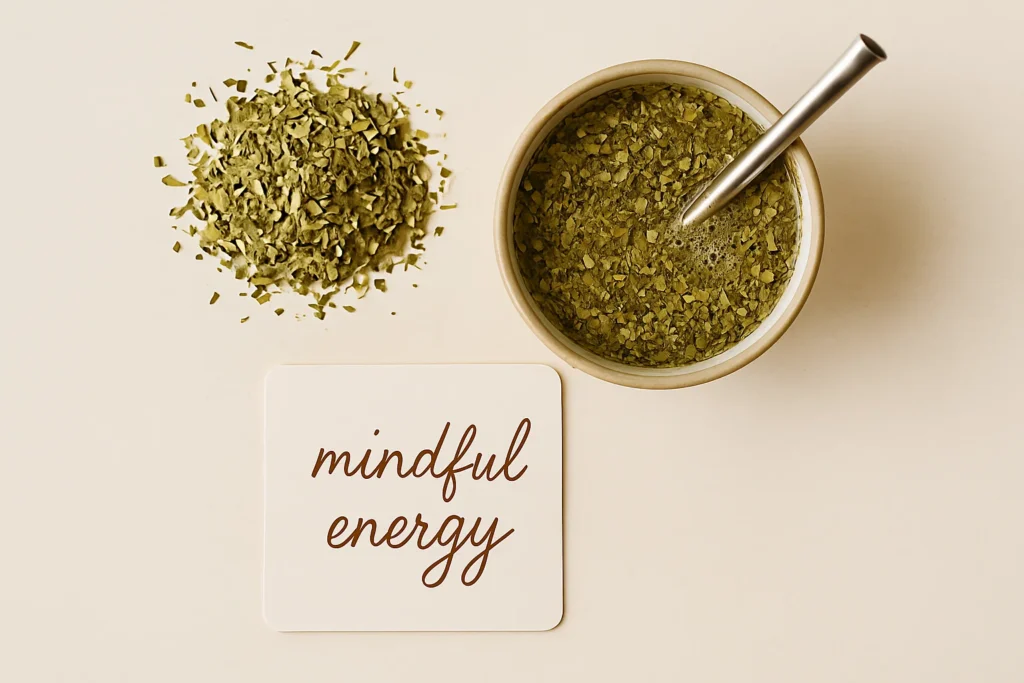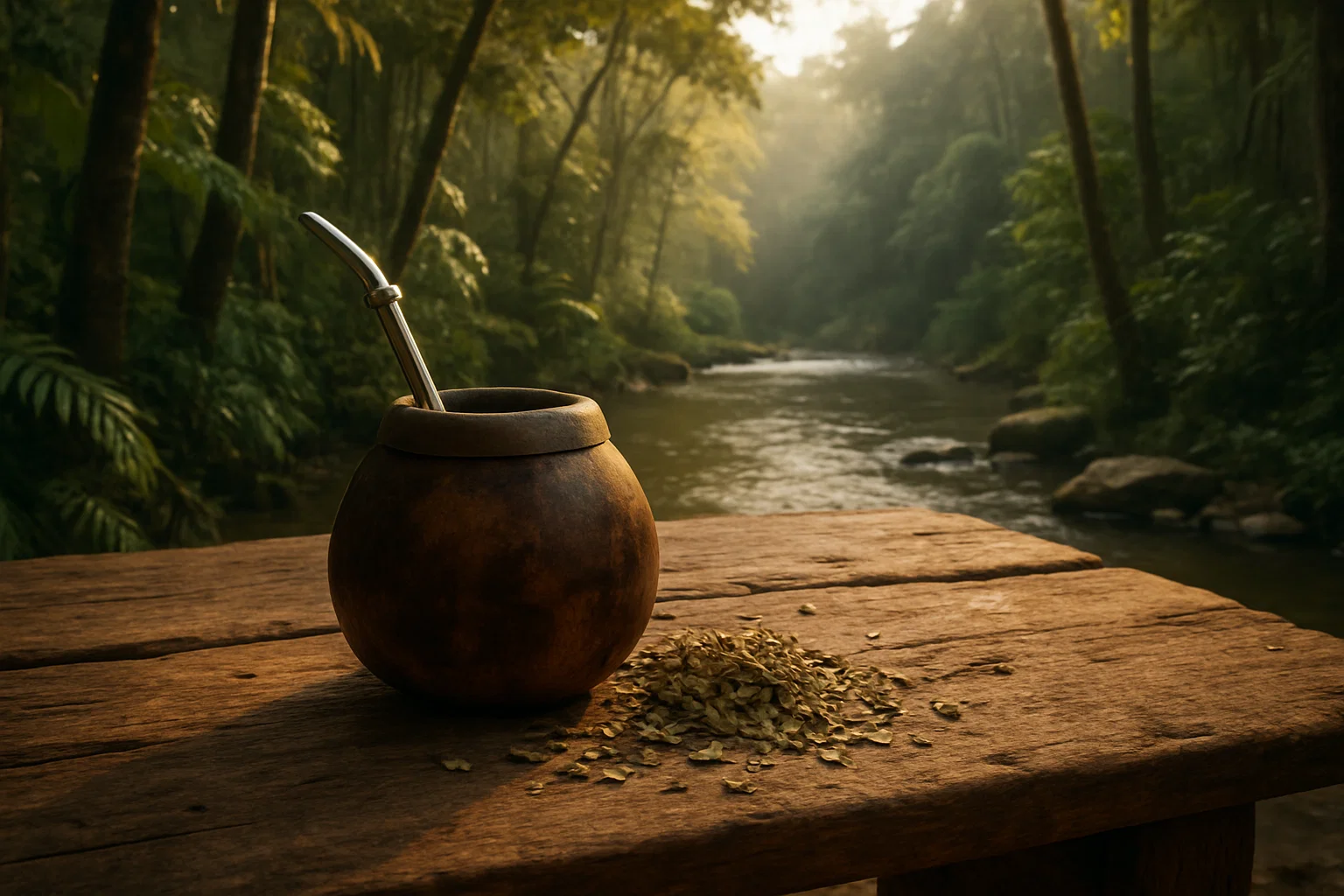More than just a tea, yerba mate is a centuries-old South American ritual that connects people and cultures in moments of calm energy. In an age of coffee-fuelled rush, mate offers something gentler – a way to feel awake, focused, and connected.
What is yerba mate
Yerba mate (pronounced [‘jɐɾbə ‘maːtə] or yair-bah MAH-tay) is a traditional South American drink made from the dried leaves of the Ilex paraguariensis plant – an evergreen shrub native to the subtropical forests of Paraguay, Argentina, Brazil, and Uruguay.
The word yerba means ‘herb’ in Spanish, and mate comes from the Quechua word mati, meaning ‘gourd’ – the hollowed-out vessel traditionally used to prepare and share the drink. When steeped in hot water, the leaves release a strong, grassy aroma and a rich, earthy taste. In its natural form its flavour sits somewhere between green tea and roasted herbs, with a hint of natural bitterness that regular drinkers learn to love. But mate is more than flavour. It’s energy, ritual, and community in one cup.
Ancient origins and cultural roots
According to Yerba Crew’s historical overview, long before colonisation and global trade, the Guaraní people of what is now Paraguay and parts of Argentina and Brazil were already drinking mate as part of daily life. They believed the plant was a gift from the gods – a natural source of strength and connection. The ritual of sharing mate was sacred, symbolising friendship, hospitality, and respect.
In the 16th century, Jesuit missionaries noticed how widely the Guaraní people drank mate and began cultivating it on a larger scale. This led to the drink spreading throughout South America, especially across the Río de la Plata region. The early European settlers adopted it quickly, seeing it as both energising and social.
Over time, the mate gourd and metal straw (bombilla) became cultural icons. Even today, in countries like Argentina, Uruguay, and Paraguay, carrying a thermos of hot water and a mate cup is as natural as taking your phone or keys when you leave the house.
Why it’s called mate
Many people outside South America assume mate means ‘friend’, but the name actually refers to the container. Traditionally made from a hollowed gourd, the mate holds the loose yerba leaves. The drinker adds a little cool water to wake the leaves, then pours in hot (but not boiling) water. The bombilla – a metal straw with a built-in filter – allows them to sip without swallowing the leaves.
Over time, the name of the vessel became the name of the drink itself. So when someone says, ‘Would you like some mate?’, they’re really saying, ‘Would you like to share this drink, this ritual with me?’
It’s a linguistic detail that says a lot about the drink’s meaning: mate is less about caffeine, and more about connection.
Then and now: who drinks it and why

For centuries, mate has been a social ritual. In the rural areas of South America, gauchos (cowboys) relied on it for stimulation and nourishment during long days working with cattle, sharing it around the campfire, passing it in between stories and songs.
Take a peak at how gauchos live:
In cities, students and friends pass it between them while studying, chatting, or relaxing. The circle of mate reflects a circle of trust – everyone drinks from the same gourd, taking turns in a rhythm of conversation and warmth.
Today, mate has travelled far beyond its roots. In cafés across Berlin, London, and New York, you’ll find modern takes – from mate lattes to sparkling cold brews. Celebrities, athletes, and creatives praise it for its smooth caffeine boost.
In Argentina, mate remains a daily staple, and according to the official website of the state of Argentina “more than 90% of households drink it” regularly. In Uruguay, it’s common to see people walking through parks with a thermos under one arm and a mate in hand. In Paraguay and southern Brazil, mate is often drunk cold (tereré) to refresh during hot summers. Whether sipped in a family kitchen or a European co-working space, mate continues to symbolise togetherness and mindfulness – a shared break in the middle of a busy day.
A ritual of connection
Drinking mate is as much about how as about what. Traditionally, one person – the cebador – prepares and refills the gourd, passing it clockwise around the group. It’s polite to drink the entire serving before handing it back for a refill. The process repeats until the leaves lose their strength, a signal that the gathering is winding down.
There’s an unspoken etiquette to it. You don’t stir the bombilla. You don’t say ‘thank you’ until you’ve had your last sip. It’s a ritual of trust, rhythm, and respect – small gestures that keep people present and connected.
For many, mate is a moment to pause. It’s a chance to listen, share, and feel part of something. That’s why it resonates so deeply with modern wellness culture: it blends energy with awareness.
Modern mate culture

In recent years, mate has gained global attention as a mindful caffeine alternative. Brands now offer mate in tea bags, canned infusions, and powders for easy preparation. Yet traditionalists still swear by the gourd and bombilla – they see them as part of the experience, not just tools.
Social media has helped spread mate culture too. Photos of friends sharing a gourd in parks or study spaces carry the same quiet message: energy doesn’t have to mean speed. You can feel awake and centred at the same time.
This modern revival aligns with the values that many young people care about – sustainability, authenticity, and connection. Yerba mate is naturally plant-based, biodegradable, and often organically grown. Many small producers in South America use traditional harvesting methods that respect both people and the environment.
Why people love it

Yerba mate contains caffeine, but also theobromine and theophylline – natural compounds also found in tea and chocolate – which offer a milder more sustained energy boost. Together, they produce what many describe as ‘calm alertness’. You feel awake, yet steady. Energised, but grounded.
If you’d like to know more about these natural substances, you can read about them in our upcoming blog on the health benefits and side effects of yerba mate.
Beyond its effects, mate carries emotional value. It reminds people to slow down, to share time instead of just caffeine. In a world of takeaway cups and solo coffee runs, mate brings back the human side of energy – warmth, stories, and connection.
A sip of connection
From the Guaraní forests to modern cafés, yerba mate has travelled through centuries and cultures without losing its essence. It remains what it has always been: a shared pause, a conversation starter, a natural source of focus.
Whether you drink it for the taste, the ritual, or the calm energy it brings, mate is more than a beverage. It’s an invitation – to connect, to listen, and to energise with intention.
If you’re just getting started, don’t worry about doing it perfectly — the beauty of mate lies in its simplicity and the small pauses it brings to your day.
👉 Curious to prepare your own? Check out our next post: Yerba mate gear 101: what you really need (and what you don’t).
👉 Want to explore the different ways to drink it — from iced mate to flavoured blends? Read 7 ways to drink yerba mate: traditional and modern twists.
Stay tuned for our upcoming post on mate health benefits and side effects, where we’ll explore how its unique combination of theobromine, theophylline, and caffeine keeps you naturally energised — without the coffee crash.
Until then — sip slow, stay mindful. 💚

